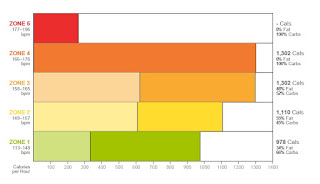Should you get tested?
No… I’m not talking about circumstances surrounding your questionable evening at the club where you blacked out and don’t remember how you got home. Mind OUT of the gutter, please.
I’m talking about having your metabolic system tested. As a Lifetime Triathlon and Endurance Coach (soon to be Metabolic Certified Coach), I have had a chance to roll up my sleeves and really get educated on what the tests are, what they tell you and best, what to do with that shiny VO2 max score and zone information.
It’s great to get your zones and VO2, but if you don’t know where to go next with it and how to improve or modify it, what good is it?
First, lets back up. Lifetime can test individuals for Resting and Active metabolic information.
Active tells you how your cardiovascular system performs under load and how and where your body fuels that activity.
Resting tells you how your body is working when you’re not working out. That’s pretty important for the fitness industry as typically most individuals are not going to see more than 1 hour a day of physical activity outside of their normal day. What’s your body doing the other 23 hours? Test, don’t guess.
Lets focus in on the Active Assessment.
Why? Because I lead with endurance training interests and I’m selfish. BUT, that will benefit you reading and those I coach in the long run. Don’t be fooled, this information is very useful for endurance athletes and those looking to improve fitness alike. The information from the active test will allow you to work smarter and harder to get better results. Run 6 to 7 miles a day and seeing no changes? This will give you some insight as to what’s really going on and what you can do to change that. It may even mean a REDUCTION in time you spend training… unless you’re a run junkie and just like to run Forrest, run.
Why is the active assessment a good place to start additionally? Glad you asked. This will give you information to adjust your workouts REGARDLESS of nutrition. Yes, you need to eat right to get real results, but if you change NOTHING about your eating habits and focus solely on workout type, load, duration, etc with the assessment information in hand, you will see results.
Do consider nutrition. Fuel source is IMMENSELY important as to how your body will perform in workouts, training and races if that’s your end game. The active assessment will give you insight on how your body produces energy. Does it burn fat, a much more plentiful energy source (and coincidentally the key component those looking to improve fitness WANT to utilize for energy production)? Or, does it go after carbs for energy, thus resulting in bonking during workouts since your body can only have so many carbs available at any given time stored in muscles and in the bloodstream?
The active assessment also reveals how healthy your cardio system really is. You may “look” healthy, but if your heart can’t provide the engine horsepower needed, you’re looking at trouble down the line.
There’s two sides to the assessment coin:
- Endurance athletes
- Looking for high VO2 (measure of cardio health)
- Lesson known – looking for high fat burning in low zones – avoid bonking on longer courses
- Fitness
- Looking for acceptable cardio health (VO2)
- Looking for high fat burning in low zones to… burn more fat and lose weight
As I mentioned, I’m looking at the endurance side usually, but I also train fitness interested clients as well since this is a great way to get them on the right path in the short term.
Sure, you walk the walk, but do you talk the talk?
Being a fitness professional at Lifetime is great, because you can volunteer for tests!
I was tested last September and then recently at a few weeks ago at the 90 Day Challenge Weigh in.
Initial testing is great, but the real proof in the pudding is the reassessments. Data over time gives you a great picture of what your effort has really given you. Did you focus on the right things in the off season? Did you lose fitness? Are you burning too many carbs now? Eat too much pumpkin pie and too many cookies over Christmas? Test, don’t guess.
Here’s a snapshot of key metrics:
 |
| Feb 2016 Zones |
 |
| Sep 2015 Zones |
 |
| Sep 2015 Fuel Source |
 |
| Feb 2016 Fuel Source |
 |
| Sep 2015 VO2 |
 |
| Feb 2016 VO2 |
What’s it all mean?
There are SOOOOO MANY takeaways from this data. It’s a real nerd fest if you’re into numbers and metrics, but I’m going to carve out 3 key metrics for my case in what I’m after as an endurance athlete.
ZONES
Where are my zones?
My important metrics are the base zone and threshold zone. When someone wants a Z1 or Z2 run or is looking at a Z4 workout, what’s that really mean? From this test, for your body, you know EXACTLY what that means. You get the speed at which you need to run and the corresponding response will follow from your body. There’s no guessing. You can run some modified tests without measuring CO2 and O2 output, but it’s really an educated guess. This isn’t a guess. Know where you’re at, know where you want to go, develop a plan to get there.
FUEL SOURCE
Where is your body getting energy from?
Fats? Carbs? Carb loading is a myth. Good carbs are great, over doing it will sabotage your metabolism. Be smart about getting your body efficient in working in the lower zones to best utilize fat for energy. The better you train in the low zones, the more effective you will be using fat. Simple as that.
VO2 – it’s not everything, but getting close.
How’s your cardiovascular system at utilizing oxygen to power the engine? If your body cannot use oxygen efficiently, it’s like burning bad gas in your car.
It’s also an indicator of stress or precursor to heart disease. We’re not doctors (well, not ALL lifetime employees are), but we can spot something that your doc may need to look deeper in to.
What does it mean to ME as a long course endurance junkie?
Personally, here’s my background:
September 2015 was leading up to the KC Marathon where I laid down my best marathon PR by far. As you can see from the test results, it gives a great indicator of where I was at and how my training was affecting my body.
Typically I can go under 4 hours for a marathon, so fat burning was on the radar, but wasn’t a high priority. I wanted to add speed over distance, which my training reflected with more Z4 and Z3 work (2 times a week) and solid Z2 work for the long runs with some race pacing mixed in = higher VO2, higher threshold since more of my work was here.
BUT, I also was coming off Ironman Boulder. It was a decent showing and I was happy to complete in a solid time after a foot injury and limited run training. As you can see though, in an event over 12 hours, that fat burning comes into play since typically you have around 2000 carbs available for energy and you can only add 200 to 300 an hour that’s absorbable (is that a word?) during a race. That 2000 may get you past the swim and carry you through the bike being able to absorb more in the saddle, but on the run it was evident I was losing the energy game. Cramps, bonking… it was a long 26.2 miles.
What did I change? The off season was a focus on more healthy fats in my body. I figured out my macro nutrients a while ago, but focused on the proteins and carbs more, and if fats met my goals, cool. The winter saw more healthy fats as in more pure cocoa in my oatmeal, natural peanut butter, grass fed butter and some other sources. FAT is FUEL, not a flavor additive. 😉
More time in Z2. Less time on longer runs at race pacing. Most of my winter work has been easier runs with 1 Z3 to Z4 workouts in addition to the bike workouts.
Results from education and testing?
Better fat burning machine. The challenge going forward?
Improve VO2 and threshold for speed over time without sacrificing fat burning. It’s a delicate balance, but thanks to the new Lifetime AMA 2.0 program, I can develop a specific plan for my situation that dictates a month of running workouts for me… then I reassess.
Also note that the test is only as good as the adherence to the protocol. The test in Sep 2015 was pretty standard, but I may have not had the right weight and body fat in, this affecting the VO2 score. Feb 2016 was after the Tri TEAM bike workout. I wasn’t sore, but I was fatigued and I also undershot the start point for the test and it went longer than typical. Test, assess, learn, move forward.
On the final note, there’s SO MUCH more to this than I have expanded on here. It’s not JUST for endurance athletes, but those looking for better fitness with limited time. There ARE enough hours in the day if you’re educated on how to use them to the full benefit. If you’re in the KC area, reach out to me and we can get you set up on the right path! If you’re out somewhere else, look up your local Lifetime Fitness and get hooked up! It’s cheaper than Dr visits, tests and medication.

